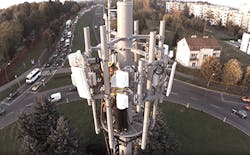Evaluating Microwave Point-to-Multipoint (PMP) and Point-to-Point (PTP) Technologies for Your Specific Application —
Enterprise network traffic is expected to increase by 6 times the volume of global broadband Internet access traffic by the end of 2030. This means it is imperative that operators deliver connectivity capable of handling this forecasted growth, especially under the current circumstances relating to the COVID-19 outbreak.
Competitive telcos and Wireless Internet Service Providers (WISPs) must help their customers meet their needs while scaling their network in a cost-efficient manner.
This is why it’s critical that operators examine the design differences between microwave point-to-multipoint (PMP) and Point-to-Point (PTP) technologies. In most cases both PMP and PTP are complementary, and often work with each other within different parts of the same network. (See Figure 1.)
Figure 1.
The fundamental use case for PMP architectures is to create a series of links between a hub site and a set of remote sites, whether these be in urban or rural areas. With the hub equipment and radio frequency channels being shared equally by the remote sites and the hub, the costs of both the spectrum and hub equipment are amortized across all links.
As PMP is available at a range of frequencies across both licensed and unlicensed spectrum, it is important operators make the correct choice when choosing the network equipment they will be deploying. As a result, many operators providing high quality corporate and residential broadband access services will prefer to use licensed spectrum, because such networks generate higher revenue, and are often sold with a specified or guaranteed throughput and availability with Service Level Agreements.
With unlicensed spectrum, there is a risk of uncontrolled interference occurring without any warning or recourse. This reduces the network’s availability, and means it is usually not suitable for corporate and critical availability access or high-performance networks.
Licensed spectrum is far more suitable, as it eliminates any possible interference through the careful and regulated allocation of channels. This produces a true carrier-grade service where high performance is guaranteed, along with reliability, which brings reduced customer churn.
The next decision operators face is whether low or high frequencies are best-suited to the kind of service they want to offer.
• Lower Radio Frequency (RF) (below 6GHz) is considered advantageous for its propagation properties, whereby the radio energy penetrates buildings and at the same time avoids obstacles. This is ideal for operators running networks such as Wi-Fi, 2G and 3G.
• However, the spectrum below 6Ghz is highly fragmented, which makes it complex for regulators to aggregate large blocks of this spectrum for lease. In turn, this can mean it is not particularly economic.
• Large parts of this spectrum are already owned by existing MNOs as they utilize it for their traditional mobile network operations.
• On the other hand, microwave frequencies between 6GHz and 60GHz are readily accessible, since these frequencies are less useful for mobile access, making them well-suited for fixed wireless
access for residential and enterprise connectivity.
InvisiLight® Solution for Deploying Fiber
April 2, 2022Go to Market Faster. Speed up Network Deployment
April 2, 2022Episode 10: Fiber Optic Closure Specs Explained…
April 1, 2022Food for Thought from Our 2022 ICT Visionaries
April 1, 2022Now that 3GPP standards have been rolled out globally, a number of bands have been identified and harmonized for 5G applications. The initial mmWave bands, between 24.5GHz to 29.5GHz, and 37GHz to 44GHz, are now being made available in various locations, and are already seeing operators seizing the opportunity.
PMP provides spectrum owners with a great way of maximizing the revenue from their assets, whilst guaranteeing customers the high speed and capacity they have come to expect.
These networks can be rapidly deployed and expanded because all operators need to know the area in which their existing and targeted new customers are located.
• It takes just 1 day to commission a PMP 4-sector hub covering up to a 10km radius.
• From that point on, it is possible to rapidly add 1 radio per customer without any need to revisit the hub site.
• Operators can also target campaigns in the area, knowing they can deliver service within just days of signing a service contract.
This technology amortizes the costs of equipment and spectrum rental over multiple links through Statistical Multiplexing Gain, where Radio Frequency (RF) spectrum needs can be reduced by a factor greater than 2. As a result, the initial expenditure of deploying PMP can be a less costly investment than the more traditional PTP solutions.
It is also possible to dynamically adapt the PMP system to support both long range at a reduced capacity or availability, and high capacity at short range by adapting the modulation order of each individual link. This makes it suitable for a wide range of use cases when it comes to backhaul for enterprise and residential services.
With PMP, network designers need to predict in advance where customers will be located, and how heavy demand is to plan the coverage of hub sectors. Sometimes, they must take a pragmatic approach and take a best guess on providing blanket coverage, which can lead to sectors not having any customers in them, and over time leads to a waste of infrastructure spending. A worst-case example of this is when designers stick rigidly to deploying 360-degree coverage, resulting in areas pointing directly towards hills or the sea, where there is never any chance of customers coming online.
As PMP hubs aggregate traffic from many sites in the coverage area, the backhaul capacity of these hub sites quickly increases.
• A new PMP hub site could start by providing services to just 10 customers.
• What can then happen, with PMP being so easy to add, is customer sites can quickly double or even triple in a very short time, placing a higher load on the backhaul.
• Network designers must then carefully consider this factor and plan the backhaul solution for each hub well in advance, for example deciding that some hubs may need to migrate the backhaul from a PTP microwave to a fibre.
Finally, as the appetite for PMP becomes greater, with the ease of adding coverage and the cost benefits, new hubs and sectors can be added in a such way that growth becomes organic.
• As with all things left to grow organically, planning shortcuts are often made to save time, and, if left unchecked, these networks can become far less efficient.
• For instance, issues with interference between adjacent hubs can occur.
• To avoid this, PMP networks need to be intelligent enough to adapt, and, secondly, PMP planning tools must be able to integrate with a network’s management system.
• This allows for the quick detection of issues, and offers rapid solutions to correct and continuously optimise the network.
Gone are the days of deploying a PMP network and leaving it alone to grow unchecked. The best PMP solutions are those that provide feedback, ensuring the best possible customer service experience.
Whereas a PTP link comes with perceived certainties, such as the dimensioned data capacity being 100% available, and that no more than 1 site will compete for a share of that traffic load.
• It is this perception that has led operators to err on the side of caution, and to connect high-value, top-priority customers using PTP, since there is no possibility that the customer will demand more than the link is provisioned for.
• The downside of this is that many PTP networks become over-dimensioned, and most of the time the full link capacity is not fully utilised.
• This results in spare capacity not being passed on to other customers, capping revenue.
When designing PTP links, a lack of line of sight may mean that reaching a particular site needs several relays installing to avoid an obstruction.
• As a result, more radios require more planning, installation work, potential points of failure, maintenance activity, and a higher cost to deploy.
• If a new building goes up, then the PTP network designer must react and change the network.
In contrast, PMP allows for far more flexibility, since a customer in a blanket coverage area can generally be served by multiple hubs, meaning the site is more likely to achieve a line of site to other sectors in the coverage zone. This flexibility allows for fewer links to be deployed to overcome line-of-site issues, and requires far less engineering activity.
Looking Ahead
Due to the global pandemic, networks are experiencing unprecedented levels of traffic with home working and learning. As the COVID-19 pandemic continues to affect our daily lives, this is likely to result in even higher bandwidth demand in the future. With so many businesses reliant on communications to stay profitable and active, operators wanting long-term success must plan ahead.
At the same time, strong industry competition means telcos and WISPs need access to solutions that can be deployed quickly, are affordable, and offer high scalability, to allow for future growth.
To deliver high-quality connectivity with no interruptions, it is critical that WISPs and telcos carefully examine when to use PMP and/or PTP. The electromagnetic spectrum is a finite resource, and needs to be used as efficiently as possible to ensure that all demand for traffic is met.
With the provision of enterprise services, operators should not underestimate the power of PMP. Its ability to deliver high capacity, dynamic range, and its easy deployment, makes this technology a great choice for providing high-quality reliable connectivity.
Telcos and WISPs can also optimize their network rollouts by providing coverage where the largest and fastest uptake in customers can be captured. Meaning their network can be up and running quickly, resulting in reduced costs and maximized revenue.
At a time when networks are facing increasing pressure and growing uncertainty due to the COVID-19 pandemic, it is critical that WISPs and telcos have a variety of tools in their network toolbox. Cambridge Broadband Networks Group can help service providers find the right solutions for their Middle and Last Mile deployments that meet their needs for the future. n
Reference and Notes
https://www.computerweekly.com/news/450421966/Equinix-expands-its-European-datacentre-footprint-with-AM4-opening-in-Amsterdam
For more information, please email [email protected] or visit https://www.cbnl.com/. You can also follow us on Twitter @CBNGTeam.










